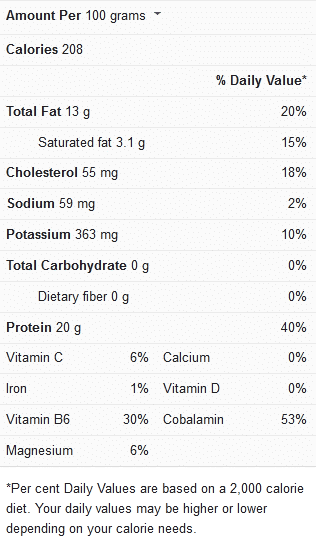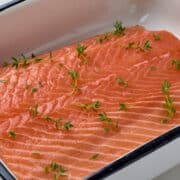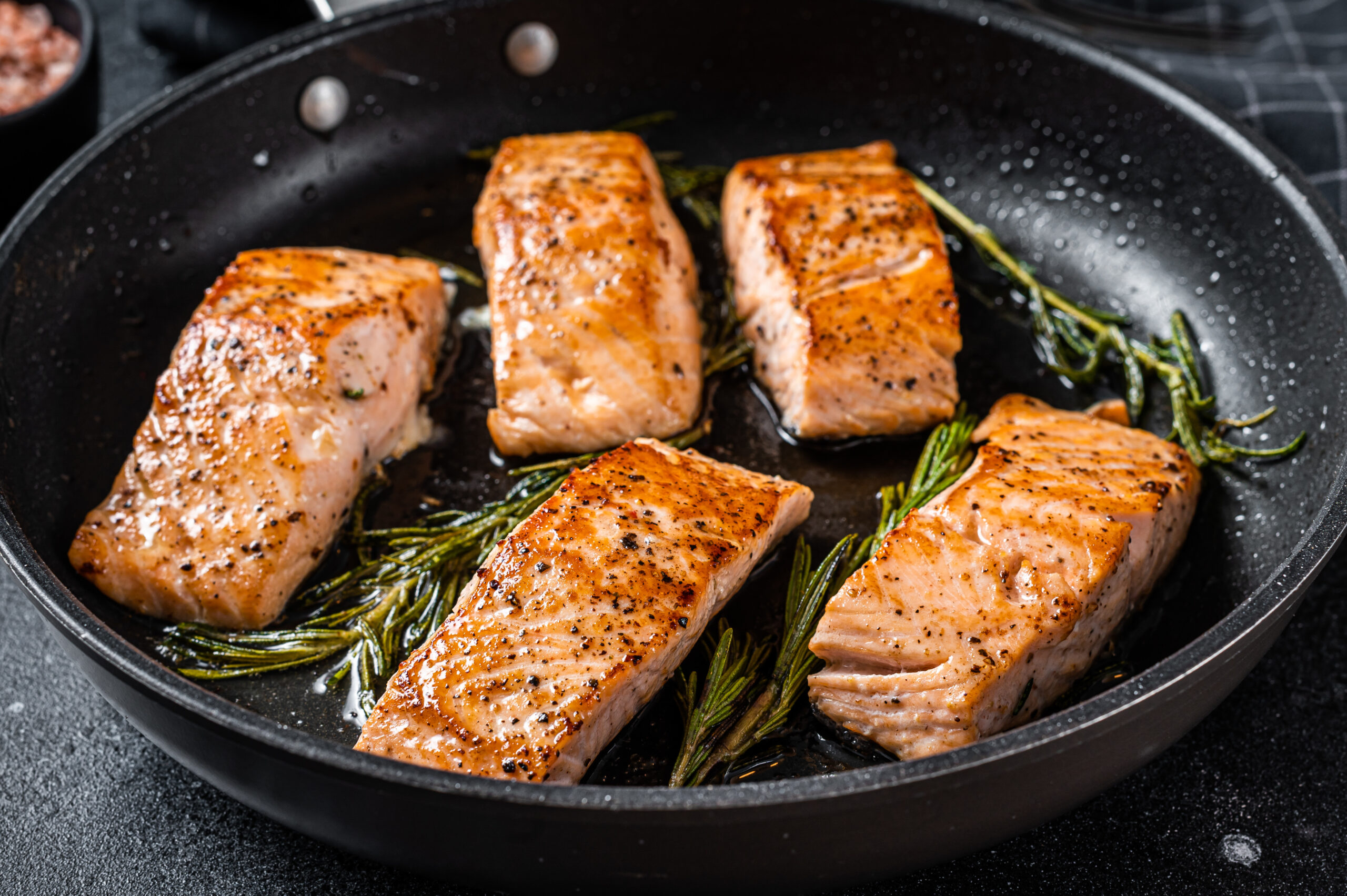Updated on October 13th, 2022
There are numerous ways to prepare salmon fillets, whatever the preference, a piece of salmon would leave your taste buds hankering for more. Despite the many ways you can prepare salmon, the easiest and fastest way to prepare this fish is to pan-sear it. Unfortunately, not every home cook can boast of having enough knowledge to successfully carry out this project.
This article contains helpful tips and guidelines to get you started on the path to making the best salmon fillets you’ve ever made, I’ve also included a table to indicate how long it takes to cook the perfect salmon, and lastly, I’ve included a quick and easy salmon recipe to kickstart dinner preparation if you are low on inspirations.
Salmon Nutrition Facts

Tips to Cook the Perfect Salmon you’ve Ever Had
Cooking salmon should not be difficult at all, but if you are still having trouble achieving the perfect crispy salmon then you should pay attention to these tips and guidelines;
Prepping the fish – before you proceed to cook anything, it is always good to prepare your ingredients beforehand, and this also applies to salmon. If you have a large piece of fish (full salmon), you should grab a kitchen knife and first cut off the head, next you want to proceed to make a long cut along the spine, after that, you should separate the fish; do this by cutting along the belly.
When you’re done with all that cutting, grab a plier and work out the pin-bones from the fish, it may take a while but this step is extremely crucial if you want flawless pieces of salmon. After that, cut the salmon into smaller portions (about 3 to 4 ounces, and 2 inches in width).
Remove the scales – descaling the salmon is another great way to make your salmon fillets crispier. You can either use a knife or a spoon to descale the fish. The scale runs from the head of the salmon to the tail, so to descale you need to run the spoon against the flow of the scales, when using a knife to descale the fish, use the blunt side of the blade. You can also separate the skin of the fish by making a thin cut between the meat part and the skin part of the fish, and slowly cutting through until the meat portion of the salmon comes off in one piece.
Pat the salmon fillets dry – the next step to achieving the perfect salmon each time would be to pat the salmon fillets dry with a paper towel. Doing this will eliminate excess moisture on the skin of the fish resulting in a crispier salmon, make sure you pat the skin side to remove as much water as you can. Removing excess moisture from your salmon also helps to minimize splattering when the fish hits the hot oil in the skillet.
Score the salmon- when the salmon fillets are introduced to heat, the heat causes them to change their shape, so to help the salmon fillets retain their shape when you fry, it is best to score them before you get started. Using a sharp knife, make small cuts on the skin side of the fish, you should avoid making deep cuts, you can always bend the fish to expose more surfaces to cut into. Scoring the fish would also help the fillets absorb the seasonings.
Season the salmon- almost every savory food needs to be seasoned, and salmon is no exception. But here you do not need fancy seasonings, just your regular salt and black pepper would do just fine. Sprinkle the seasonings on both sides of the fillet, make sure you do this when you are just about to cook the salmon because salt draws out moisture from the fish, and you don’t want that here. If you season the fish too early, you can always pat them dry before cooking.
Do not cook salmon cold – avoid cooking salmon cold, when you get it out of the refrigerator you should allow it to come to room temperature by placing it in a plate or bowl for some minutes. What this does is it allows the fish to cook much quicker and prevents the outside from drying up.
Preheat the skillet bare- just before you start cooking the salmon, you should preheat your skillet until it is nice and hot, avoid adding your cooking oil to a cold skillet because you do not want to burn the oil. Another thing to consider is getting a cooking oil with a high smoke point.
Always cook skin side down first – one common mistake amateur cooks make is that they cook salmon meat side down. Cooking it skin-side down is the right way to cook salmon. You can split out your cooking time, and use 80% of the time to cook the skin side and 20% to cook the meat side.
Press the salmon fillet down – to get the skin side of the salmon to remain flat and avoid buckling, you need to apply pressure on the salmon. You can use a spatula or the back of a spoon to gently press the salmon down for some seconds.
View this post on Instagram
Cooking Time for Salmon in Skillet
| Cooking procedure | Cooking time |
| Cooking salmon (skin side down) in skillet ok medium heat | 5 to 6 minutes |
| Cooking salmon (meat side down) in skillet ok medium heat | 1 to 2 minutes |
Quick salmon in a skillet (4 servings)
Ingredients
- 4 portions of 2-inch salmon fillet
- Olive oil
- 1 tablespoon minced garlic
- 1 teaspoon lemon zest
- 1/4 cup lemon juice
- Salt
- Ground black pepper
- 3 tablespoons unsalted butter
Instructions
- Prepare salmon fillets by descaling with a spoon and drying them with a paper towel
- Place salmon fillets on a flat plate and leave them out at room temperature for 3 – 5 minutes.
- Season salmon fillets with 1 teaspoon each of salt and black pepper
- Preheat your skillet over medium heat for about 2 minutes, add the olive oil and increase to medium-high
- The oil should start to shimmer after a minute or two, when it happens, add your salmon (skin side down), add them one after another, pressing down gently on each piece of fillet for about 10 seconds with a spatula.
- Reduce to medium heat and continue cooking the salmon, pressing down on each fillet. Cook for about 6 minutes.
- Gently flip the salmon over with a tong, and cook the flesh side for about 1 to 2 minutes.
- Transfer the salmons to a plate lined with a paper towel to drain off excess oil. Prepare the sauce in the meantime.
- In the same pan used to cook the salmon, add 1 tablespoon minced garlic and 1 teaspoon lemon zest and sauté for 30 seconds
- To the pan, add 1/4 cup of lemon juice, 1/2 teaspoon of salt, and a 1/4 teaspoon of black pepper, stir properly and cook for 1 minute.
- Turn off the heat, and whisk in 3 tablespoons of unsalted butter. Mix properly until it is well incorporated.
- Add the salmon to the pan and baste with the garlic-butter sauce, transfer to serving plates and enjoy.
This delicious salmon in a skillet recipe works like a charm every time, make sure you try it out. If you would also love to see other recipe ideas, check out this video recipe.

